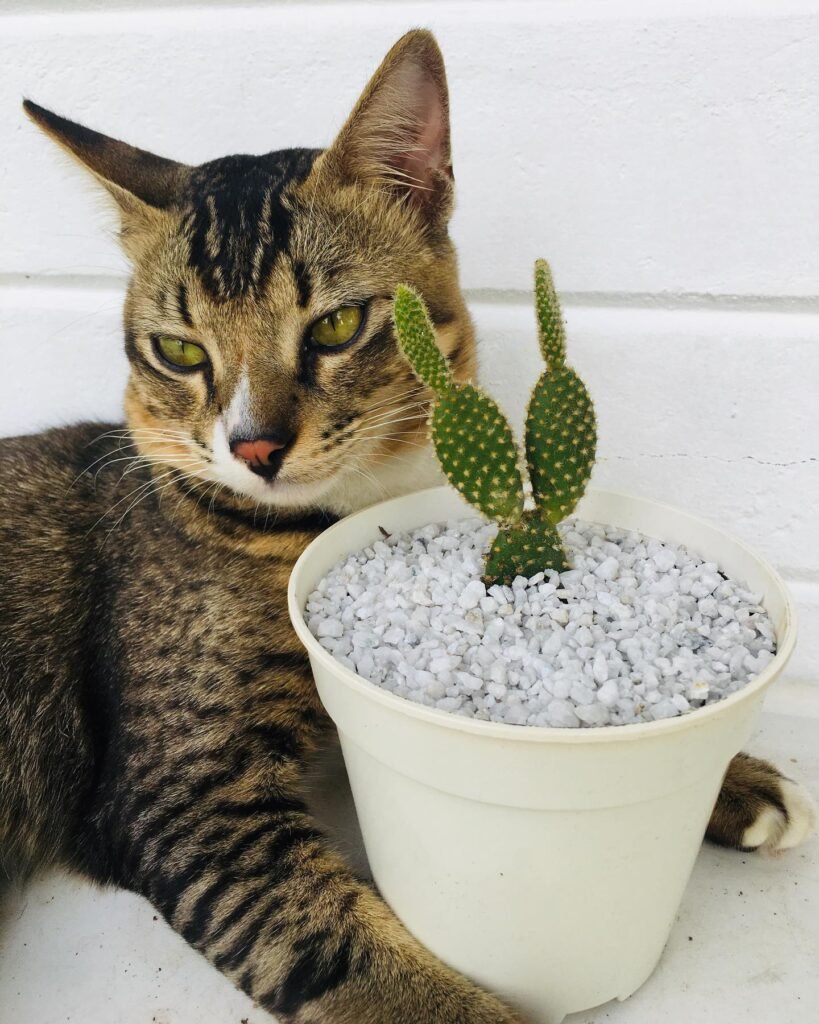The Opuntia microdasys, affectionately dubbed the Bunny Ear Cactus, has become a beloved addition to homes throughout the UK. Its unique pads, reminiscent of a rabbit’s ears, have endeared it to many indoor gardeners. In this guide, I’m excited to share with you the best practices for caring for this charming succulent. We’ll explore the essential tips to ensure your Bunny Ear Cactus flourishes, bringing a touch of whimsy and greenery into your living space.
Appearance of Opuntia microdasys (Bunny Ear Cactus)

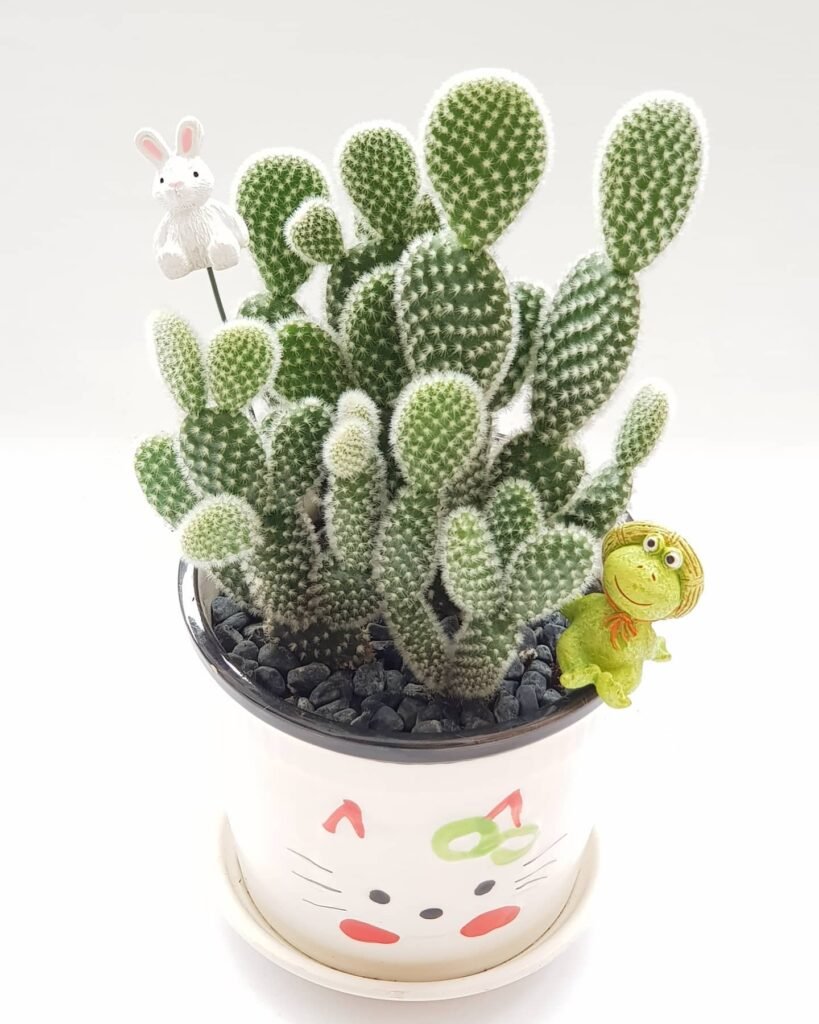
The Opuntia microdasys, affectionately known as the Bunny Ear Cactus or Pricklypear, is a captivating plant with its unique structure and appearance. This cactus features flattened, oval-shaped stems, commonly referred to as “pads,” which resemble the ears of a bunny, lending the plant its charming name. These pads are adorned with small clusters of spines called glochids, which can vary in colour from yellow and white to rusty orange, adding a distinctive contrast to the green of the pads.
What makes the Bunny Ear Cactus particularly appealing as a houseplant is the deceptive fluffiness of these spines. From a distance, the glochids give the cactus a soft and inviting texture, contributing to its attractiveness. However, this aesthetic feature comes with a caution: despite their fluffy appearance, the spines are sharp and can easily embed themselves in the skin if the cactus is not handled with care.
This intriguing combination of soft visuals with a need for careful handling adds to the character of the Opuntia microdasys, making it a fascinating addition to any indoor plant collection. Its appearance is not only visually striking but also a topic of conversation, blending the rugged allure of cacti with a touch of playful charm.
 The Opuntia microdasys, known as the Bunny Ear Cactus, sports glochids instead of true spines. These tiny, barbed bristles can detach and irritate skin, serving as a defence against herbivores in its desert home.
The Opuntia microdasys, known as the Bunny Ear Cactus, sports glochids instead of true spines. These tiny, barbed bristles can detach and irritate skin, serving as a defence against herbivores in its desert home.
Light Requirements for Opuntia microdasys
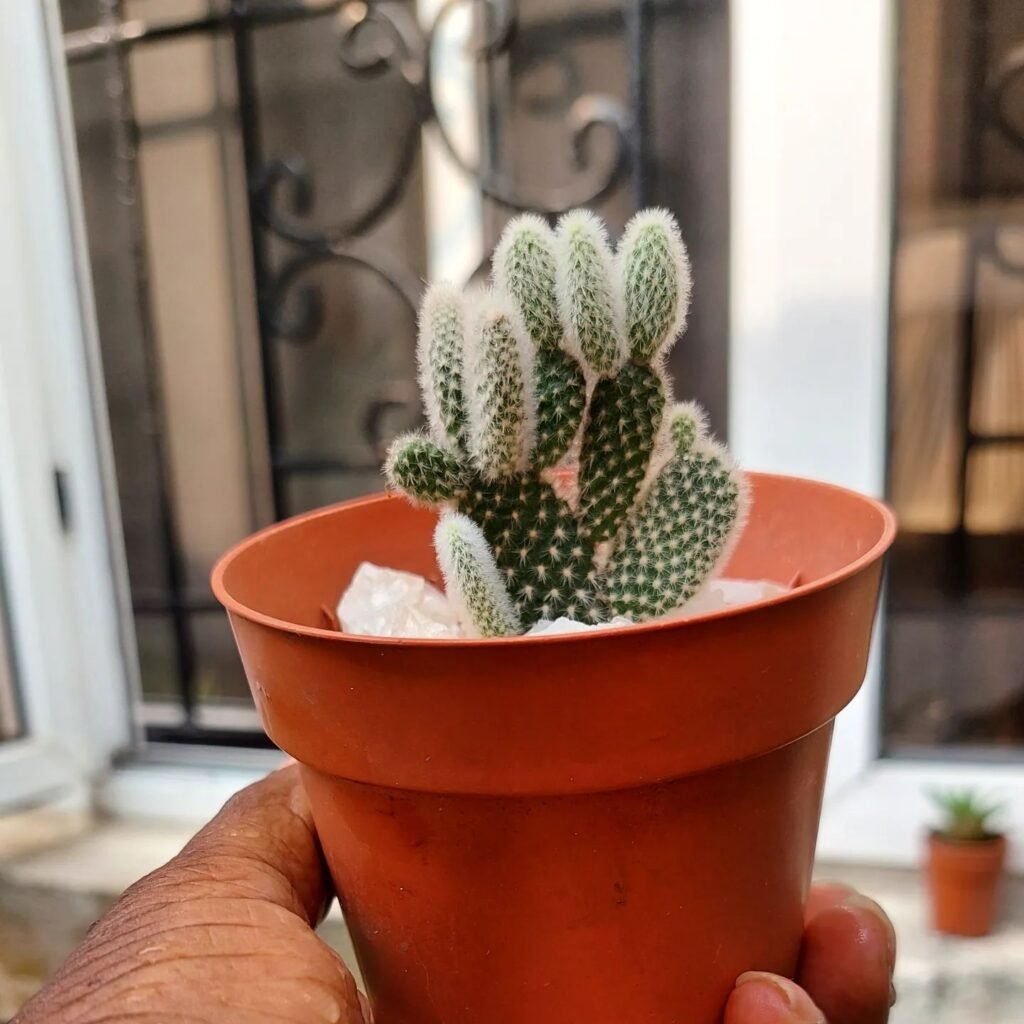
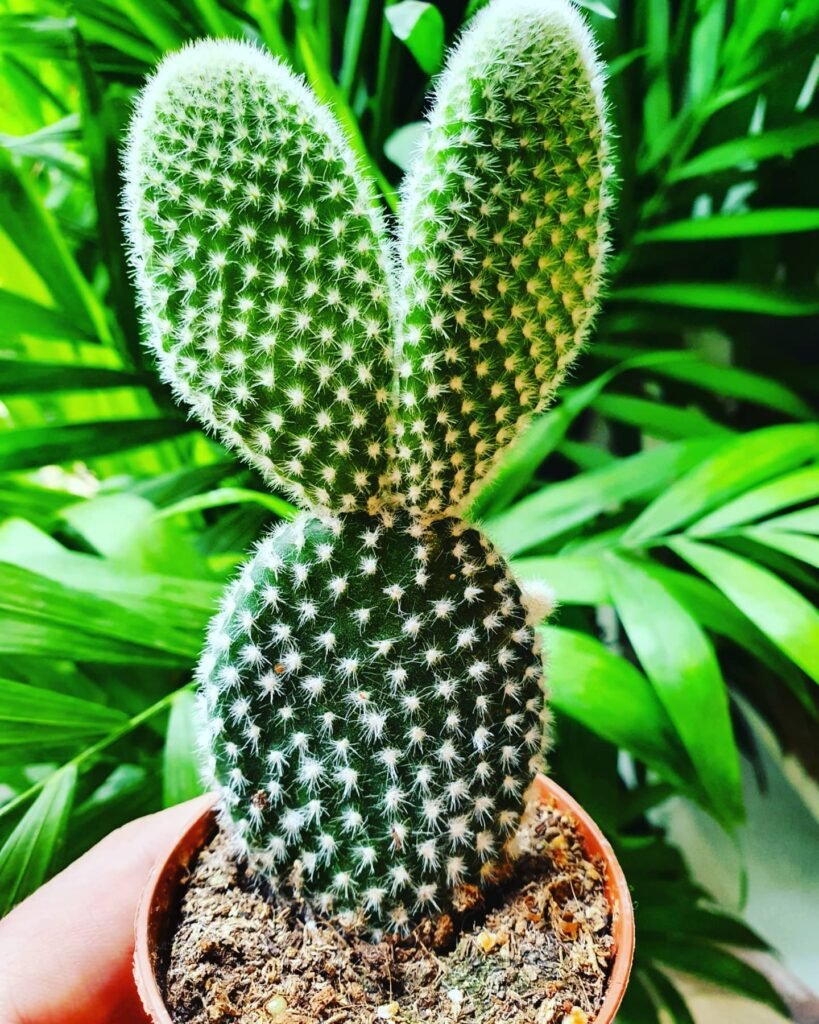
The Opuntia microdasys, more commonly referred to as the Bunny Ear Cactus, is a plant that flourishes under the brilliance of bright, direct sunlight. This cactus’s love for the sun is paramount for its growth and maintenance of its distinctive appearance. Here are a few key points to ensure it thrives in your care:
- Sunlight Preferences: The Bunny Ear Cactus prefers to bask in full, direct sunlight. While it’s somewhat forgiving and can manage with some indirect light, it’s crucial to understand that too much shade can adversely affect its growth. Inadequate sunlight may cause the cactus to lose its unique shape and vibrant health.
- Ideal Placement: To cater to its light requirements, positioning your Bunny Ear Cactus near a window that soaks up the sun all day long is best. Windows facing south or southwest are particularly ideal, offering the plant an abundance of sunlight. This ensures the cactus not only survives but thrives, showcasing its full beauty and unique structural integrity.
- Adaptability: Although it has a preference for plentiful sunlight, the Opuntia microdasys is adaptable to some degree of indirect light. However, striking the right balance is key to avoid any negative impact on its growth or form.
By adhering to these guidelines, you can provide the optimal environment for your Bunny Ear Cactus, allowing it to flourish and become a striking feature in your home. Its need for abundant sunlight mirrors its natural habitat, and catering to this will ensure you enjoy the full beauty and unique characteristics of the Opuntia microdasys.

Watering Tips for Opuntia microdasys (Bunny Ear Cactus)
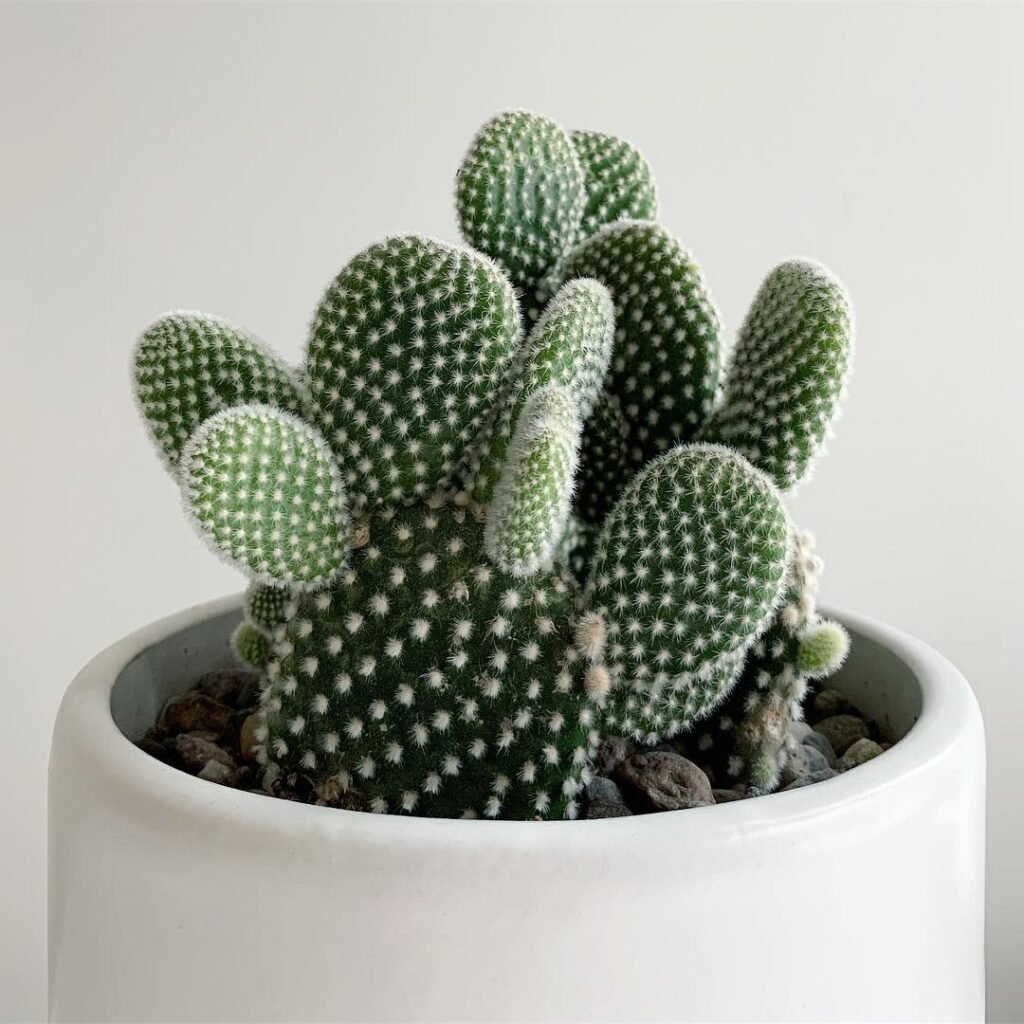
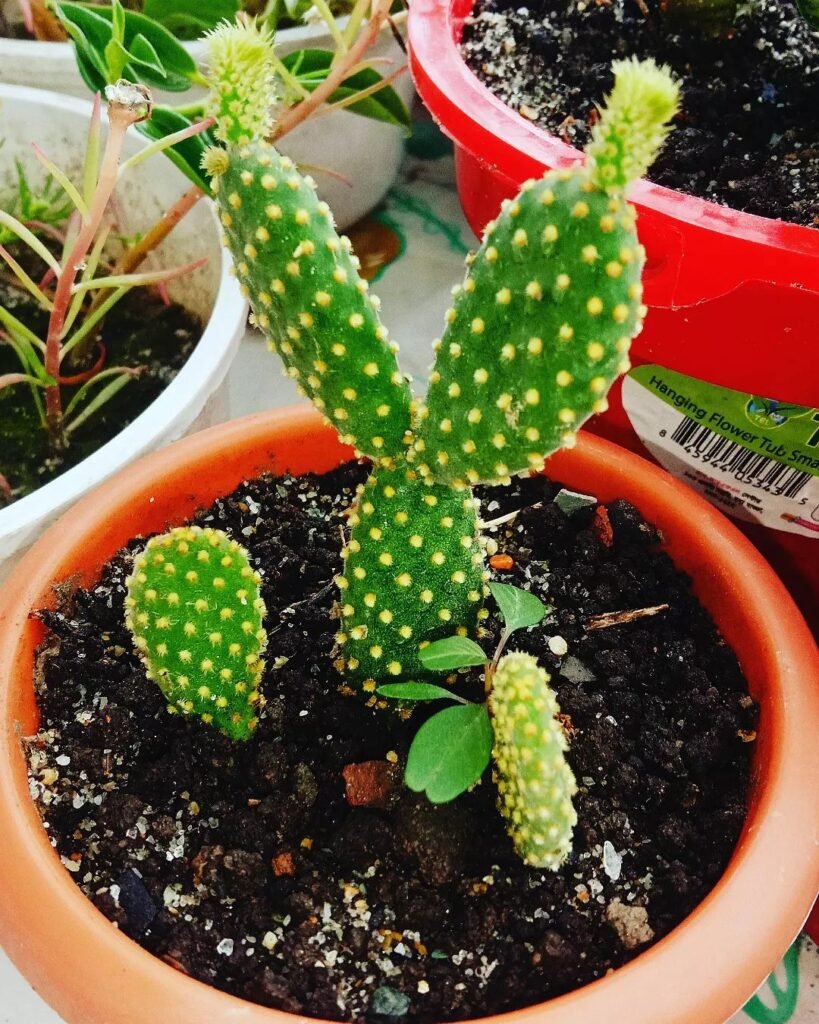
Opuntia microdasys, also known as the Bunny Ear Cactus, is a drought-tolerant plant that requires infrequent watering. To ensure the health of your Bunny Ear Cactus, follow these watering tips:
- Allow the soil to completely dry out between watering: Opuntia microdasys prefers to be watered sparingly. Wait until the soil is completely dry before watering again, which usually takes around 2-3 weeks. Overwatering can lead to root rot and harm the cactus’s overall health.
- Water the soil directly: When watering, it’s crucial to water the soil directly rather than the cactus pads. This helps prevent rotting and ensures the water reaches the root system where it’s needed most.
Remember, it’s better to underwater than overwater your Bunny Ear Cactus. This succulent plant is adapted to thrive in arid conditions, so it’s best not to overdo it with watering. Stick to these watering tips to keep your Opuntia microdasys healthy and happy.

Fertilizing and Soil for Opuntia microdasys


Opuntia microdasys, also known as the Bunny Ear Cactus, requires minimal fertilization. During the summer months, you can give your cactus a boost by feeding it with a cactus and succulent fertilizer. This will provide the necessary nutrients for healthy growth and vibrant pads. Be sure to follow the instructions on the fertilizer packaging for the correct dosage and frequency of application.
When it comes to soil, choosing the right type is crucial for the well-being of your Opuntia microdasys. It is essential to use a well-draining soil mix specifically designed for cacti and other succulent plants. A suitable soil mix can be prepared by combining multipurpose peat-free compost, horticultural sand, and horticultural grit. This mixture ensures proper drainage, preventing waterlogged soil that can lead to root rot.
Remember, the key to a healthy Bunny Ear Cactus is to strike the right balance in fertilizing and providing the appropriate soil conditions. With the right care, your Opuntia microdasys will thrive and bring a touch of desert charm to your indoor garden.

Pruning and Maintenance for Bunny Ear Cactus
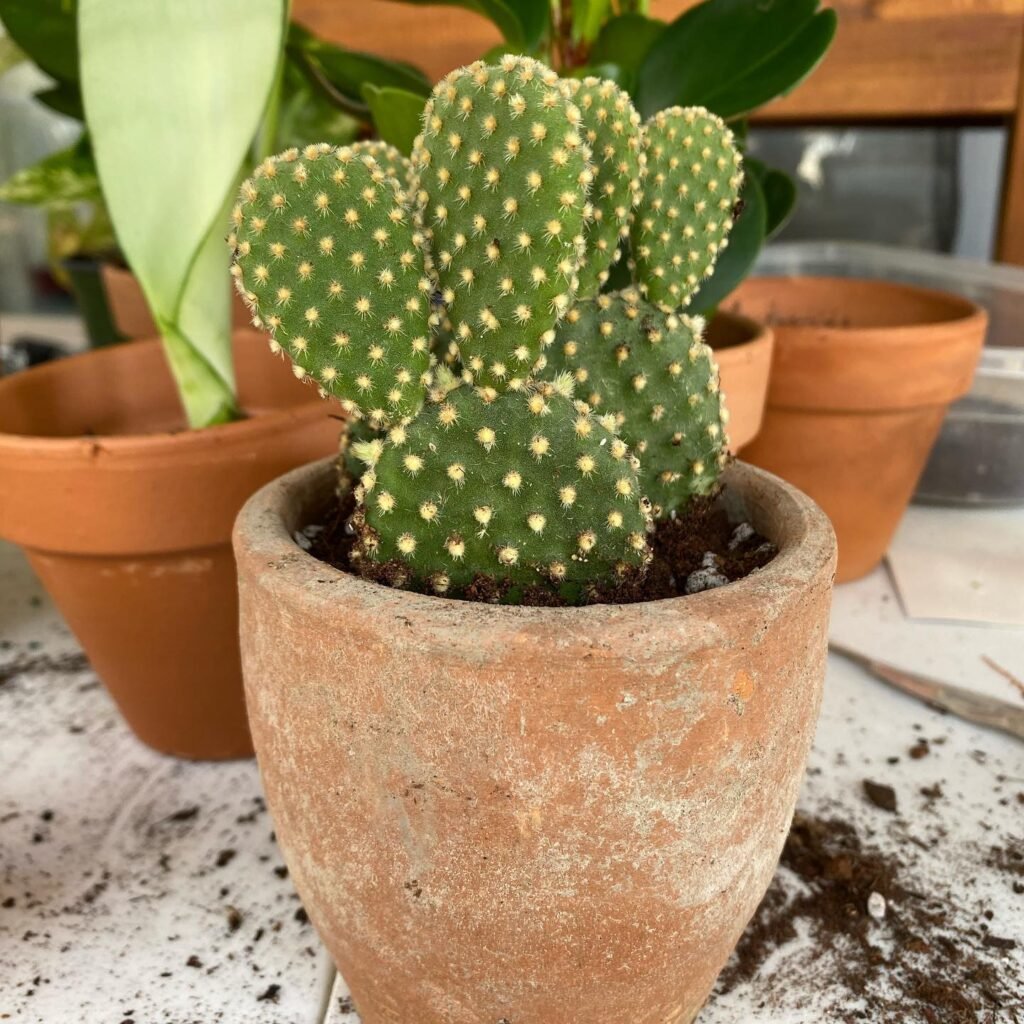
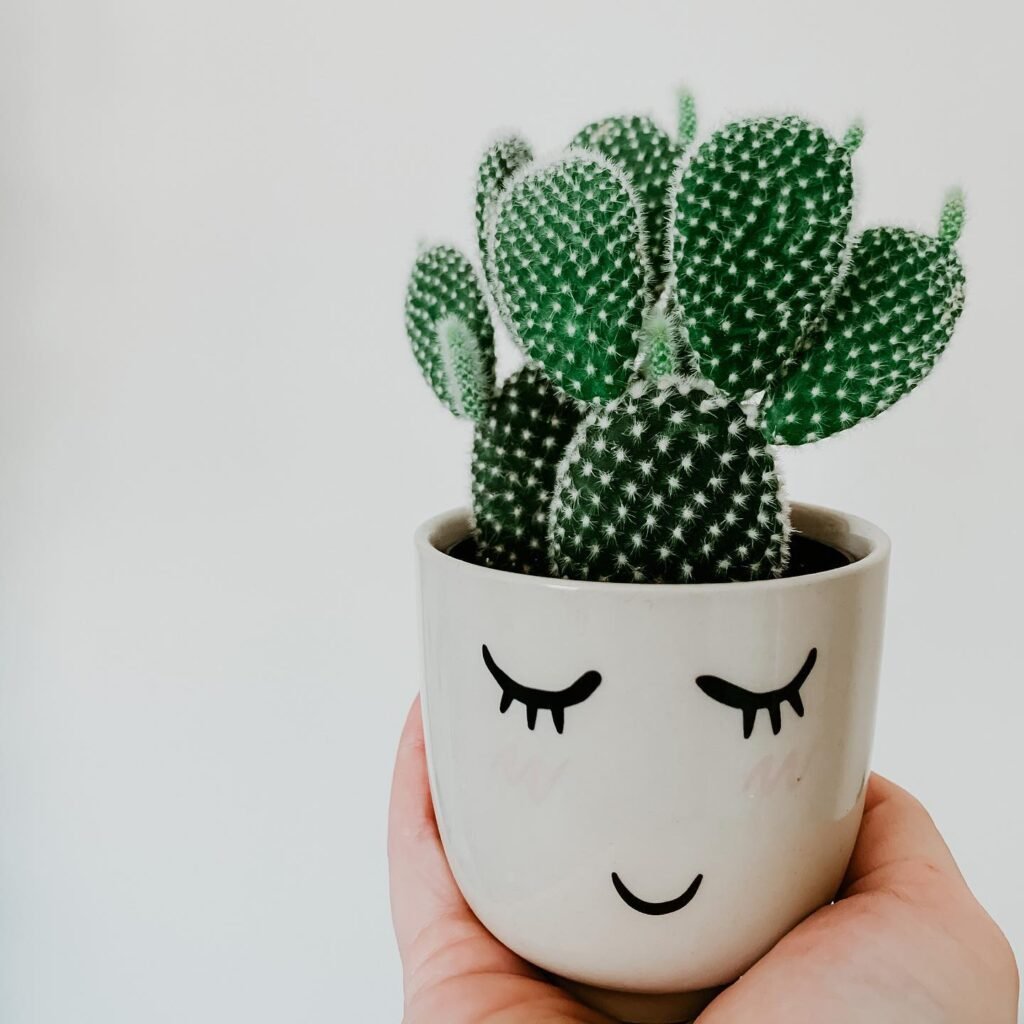
When it comes to Opuntia microdasys, pruning is generally not necessary. However, if you notice any dead or damaged pads, removing them can help improve the overall appearance of the cactus. Just remember to be cautious while handling the cactus to avoid getting pricked by its spines. The spines can cause irritation and discomfort if they come into contact with your skin, so it’s important to handle the cactus with care.
In terms of maintenance, regular inspection for pests is crucial to ensure the health of your Bunny Ear Cactus. Pay close attention to pests such as mealybugs and spider mites, as they can pose a threat to the cactus. If you notice any signs of pest infestation, it’s important to take appropriate measures to eradicate them and prevent further damage to your plant.

Propagating Opuntia microdasys (Bunny Ear Cactus)
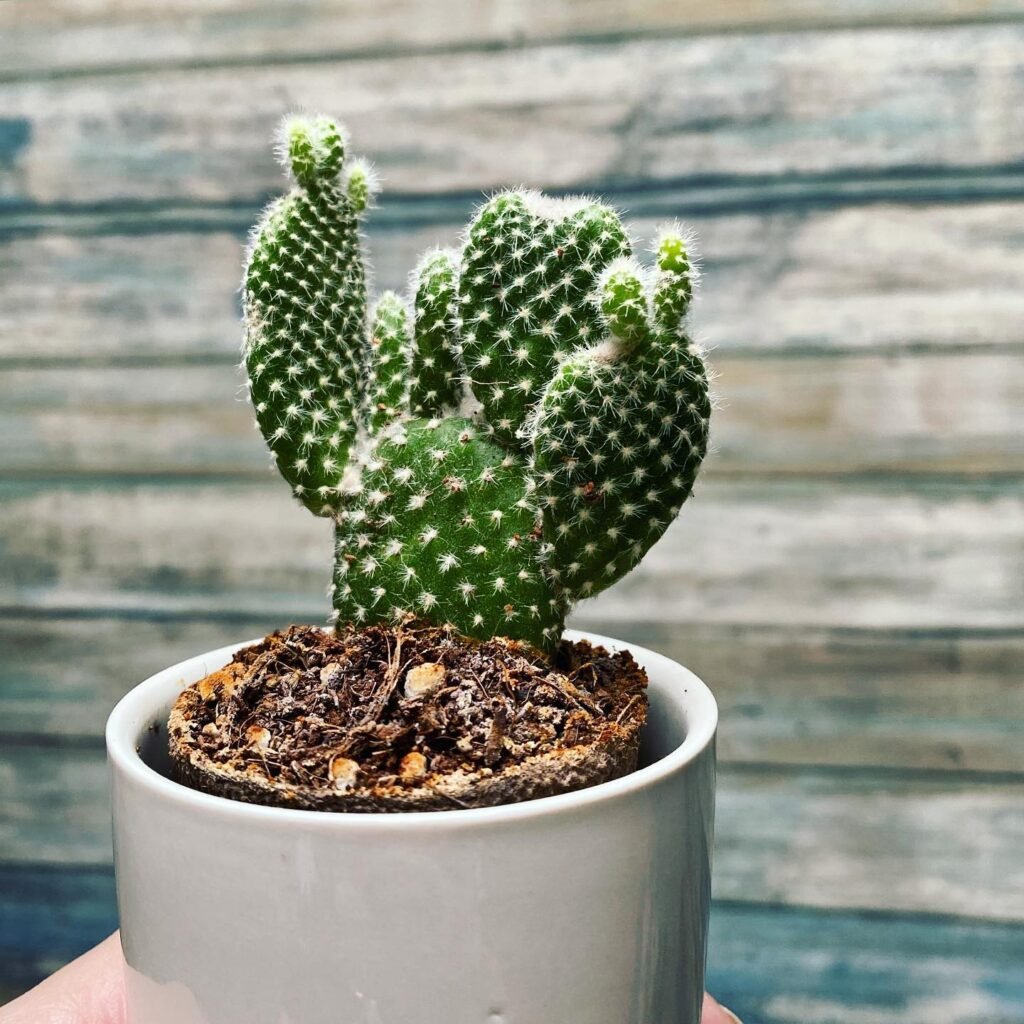
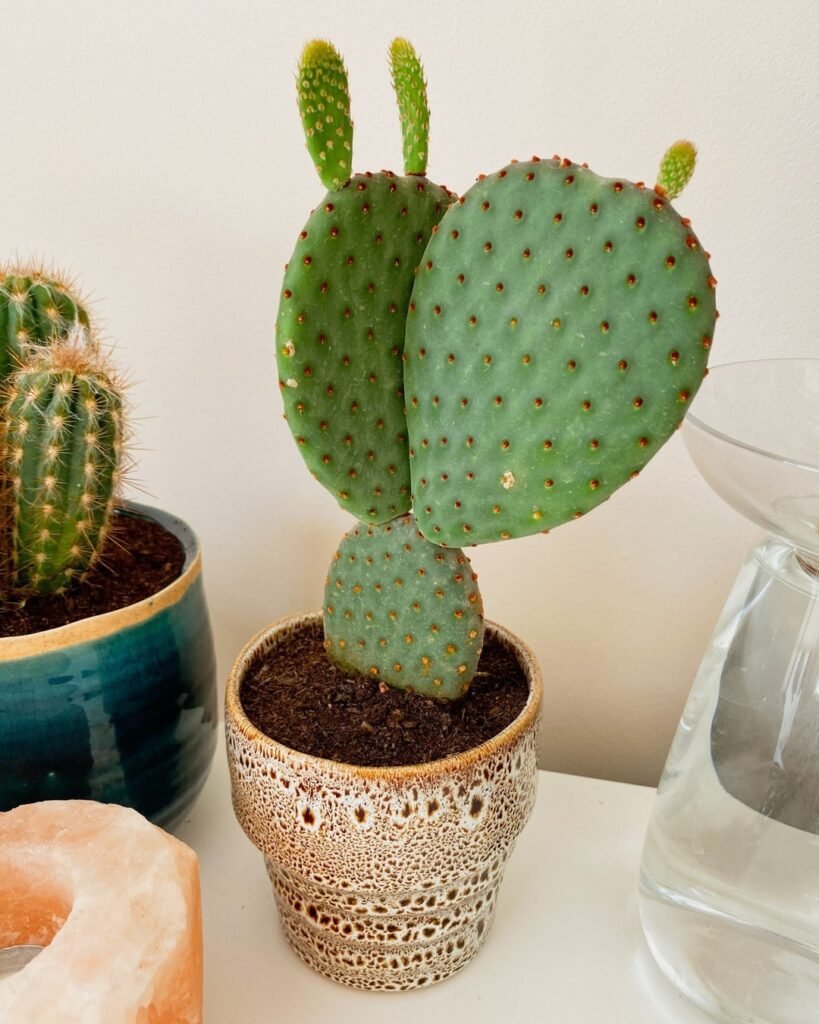
If you’re looking to expand your collection of Opuntia microdasys, propagating this Bunny Ear Cactus is a rewarding and straightforward process. By following these simple steps, you can create new plants from whole pads or stems removed from the parent plant.
To ensure successful propagation, it’s best to undertake this process during the summer months when the cactus is in its active growing phase. Here’s how you can propagate Opuntia microdasys:
- Start by selecting a healthy pad or stem from the parent plant. Ensure that it is free from any signs of damage or disease.
- Using a clean and sharp knife or pair of scissors, carefully remove the pad or stem from the parent plant. Aim to make a clean cut without damaging the remaining parts of the cactus.
- After removing the pad or stem, allow it to callus over for 2-3 days in a warm and dry area. This callusing process helps prevent rotting and promotes the formation of new roots.
- Once the pad or stem has callused, fill a pot with well-draining compost suitable for cacti and succulents. You can also partially bury the pad in the compost if desired.
- Place the pad on top of the compost or bury it slightly, ensuring that it is in contact with the soil. Avoid covering it completely as this can hinder root growth.
- Keep the compost slightly moist but not waterlogged during the propagation process. Watering the pad or stem gently when the soil feels dry to the touch is sufficient.
- Place the pot in a bright and warm location, preferably near a window that receives ample sunlight. This will encourage root development and overall growth.
- Be patient and give the propagating pad or stem time to establish roots. It may take several weeks or even months before you start to see signs of new growth.
Remember, propagating Opuntia microdasys can be a gradual process, but with patience and the right care, you’ll soon have new Bunny Ear Cactus plants to enjoy.

Repotting Tips for Opuntia microdasys
Repotting Opuntia microdasys is an essential part of caring for this Bunny Ear Cactus. It should be done when the cactus has outgrown its current pot or when the soil becomes overly compacted.
Choosing the Right Pot and Soil
When repotting Opuntia microdasys, select a pot with proper drainage holes to prevent waterlogging, which can lead to root rot. Use a well-draining soil mix specifically formulated for cacti and succulents. This type of soil will ensure adequate drainage and promote healthy root growth.
Handle with Care
During the repotting process, it’s important to be cautious of the spines on the Bunny Ear Cactus. These spines can cause discomfort and irritation if they come into contact with the skin. Use protective gloves or a rolled-up newspaper to handle the cactus and avoid getting pricked.
Tip: To remove Opuntia microdasys from its current pot, gently tilt the pot and tap the bottom to loosen the roots. Then, grasp the base of the cactus firmly and gently lift it out of the pot.
Allow for Settling
After repotting, it’s crucial to give the cactus time to settle into its new pot before watering. This period of adjustment allows the roots to establish themselves in the fresh soil and reduces the risk of root damage. Wait for approximately one week before resuming the regular watering schedule for Opuntia microdasys.
Tip: Avoid overwatering newly repotted Opuntia microdasys. Stick to the recommended watering frequency to prevent the risk of root rot.
 The Opuntia microdasys, or Bunny Ear Cactus, employs CAM photosynthesis to conserve water in deserts by opening its stomata at night. A smart strategy for survival in arid conditions.
The Opuntia microdasys, or Bunny Ear Cactus, employs CAM photosynthesis to conserve water in deserts by opening its stomata at night. A smart strategy for survival in arid conditions.
Toxicity of Opuntia microdasys (Bunny Ear Cactus)
Opuntia microdasys, commonly known as the Bunny Ear Cactus, is a popular houseplant due to its unique appearance and low maintenance requirements. One important aspect to consider when keeping this cactus as a houseplant is its toxicity. While Opuntia microdasys is generally considered non-toxic, it does have small spines on its pads that can cause discomfort and irritation if touched or ingested.
It’s advisable to keep the Bunny Ear Cactus out of reach of children and pets to prevent any potential accidents. The spines can embed in the skin, causing irritation, redness, and swelling. Ingesting the spines may lead to gastrointestinal discomfort. Therefore, it is recommended to place the cactus in a location where it cannot be easily touched or accidentally knocked over.
As with any houseplant, it’s important to exercise caution when handling Opuntia microdasys. Wear protective gloves if necessary, and avoid placing the cactus near areas where it may pose a risk of injury. By taking these precautions, you can enjoy the beauty of the Bunny Ear Cactus without worrying about any potential toxicity concerns.
Helpful Videos about Opuntia microdasys (Bunny Ear Cactus)
Take a gander at these fantastic videos I’ve stumbled upon, all about caring for the Opuntia microdasys, also known as the Bunny Ear Cactus. They’re packed with advice to simplify looking after your cactus, making it absolutely straightforward. Perfect for those keen on diving into the world of gardening!
- Opuntia microdasys (Bunny Ear Cactus) Houseplant Care
- Cactus care for beginners | Bunny Ears Propagation – Opuntia Microdasys –
FAQ about Caring for Opuntia microdasys (Bunny Ear Cactus)

Curious about the best ways to care for your Opuntia microdasys, the charming Bunny Ear Cactus? You’ve landed in the perfect place! I’ve compiled all the top queries to assist you in nurturing your cactus effortlessly. Whether it’s figuring out the ideal watering schedule or addressing prickly issues, you’re sorted.
Opuntia microdasys, known as the Bunny Ear Cactus, is a type of prickly pear cactus with pad-like stems resembling rabbit ears. Originating from Mexico, it’s a popular houseplant in the UK for its unique shape and minimal care requirements.
It thrives in bright, direct sunlight. In the UK, place it in a south-facing window where it can get several hours of sunlight daily.
This cactus prefers warmer temperatures, ideally between 21°C to 30°C during the day. It can tolerate cooler temperatures at night and during winter but should not be exposed to temperatures below 10°C.
Water sparingly. In summer, water every 1-2 weeks, allowing the soil to dry out completely between waterings. In winter, reduce watering to once a month or less, as the plant enters a dormant phase.
Use a well-draining cactus or succulent potting mix. Adding perlite or sand can improve drainage, which is crucial to avoid root rot.
Bunny Ear Cactus prefers a dry environment. High humidity, typical in some parts of the UK, can lead to problems. Ensure good air circulation around the plant.
Repot every 2-3 years during spring. Choose a pot only slightly larger than the current one and handle the plant carefully to avoid damaging the pads or injuring yourself on the spines.
Yes, but it must be in a very sheltered, sunny spot and brought indoors before the temperatures drop in autumn, as it cannot withstand the cold UK winters.
Common pests include mealybugs and spider mites. Inspect regularly and treat with insecticidal soap or neem oil if pests are detected.
Yellowing can be a sign of overwatering, poor drainage, or too much direct sunlight. Adjust your care routine accordingly.
Propagate by gently removing a pad and allowing the cut end to callous over for a few days before planting in well-draining soil.
These are glochids, tiny barbed spines that can easily detach and irritate the skin. Handle with care, preferably wearing gloves.
Use tweezers to remove any visible glochids. Washing the area with soap and water or using an adhesive tape to pull them out can also help.
It can survive, but growth will be slow, and the plant may become leggy as it stretches towards the light source. Provide as much light as possible.
Yes, but sparingly. Use a diluted, balanced cactus fertilizer once in the spring and once in the summer.
In the UK, indoors, it can grow up to 60-70 cm tall and wide, depending on the pot size and care provided.
No, misting can increase humidity around the plant, which can lead to fungal diseases. It prefers a dry environment.
Bunny Ear Cactus rarely blooms indoors. Providing optimal growing conditions, with plenty of sunlight and a period of cooler rest in winter, may encourage flowering.
The plant itself is not toxic, but the glochids (tiny spines) can cause skin irritation and should be handled with care. Keep away from pets and children who might touch or ingest the plant.
Gently brush the pads with a soft brush, such as a paintbrush, to remove dust. Avoid using water directly on the pads to prevent water retention in the glochids.
I hope this FAQ has made things clearer about caring for your Opuntia microdasys, or Bunny Ear Cactus. If you’ve got more questions, don’t hesitate to ask in the comments. I’m here to help. Remember, we all start from scratch with plants, and there’s always something new to learn as you grow with your spiky companion.

